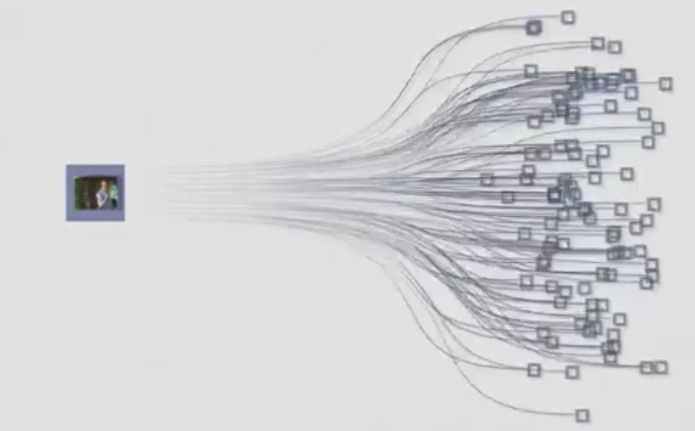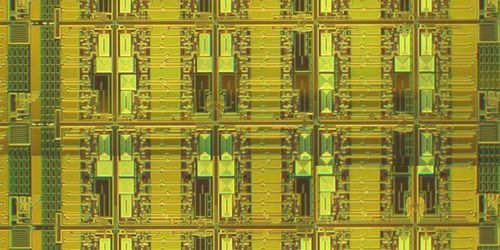When Art Inspires AI; AI composes music.
Who says AI is only for big data crunching and driverless car driving?



Columbia Engineering Professor Changxi Zheng’s new approach could lead to better tagging and coding, leveraging 3D printing of complex geometries.
New York — July 18, 2016 — Columbia Engineering researchers, working with colleagues at Disney Research and MIT, have developed a new method to control sound waves, using a computational approach to inversely design acoustic filters that can fit within an arbitrary 3D shape while achieving target sound filtering properties. Led by Computer Science Professor Changxi Zheng, the team designed acoustic voxels, small, hollow, cube-shaped chambers through which sound enters and exits, as a modular system. Like Legos, the voxels can be connected to form an infinitely adjustable, complex structure. Because of their internal chambers, they can modify the acoustic filtering property of the structure—changing their number and size or how they connect alters the acoustic result.
“In the past, people have explored computational design of specific products, like a certain type of muffler or a particular shape of trumpet,” says Zheng, whose team is presenting their paper, “Acoustic Voxels: Computational Optimization of Modular Acoustic Filters,” at SIGGRAPH 2016 on July 27. “The general approach to manipulating sound waves has been to computationally design chamber shapes. Our algorithm enables new designs of noise mufflers, hearing aids, wind instruments, and more — we can now make them in any shape we want, even a 3D-printed toy hippopotamus that sounds like a trumpet.” VIDEO: http://www.cs.columbia.edu/cg/lego/

The warning from QuintessenceLabs’ CTO John Leisoboer is stark. “When sufficiently powerful quantum computers become generally available,” he says, “it’s guaranteed to break all existing cryptographic systems that we know of.”
In other words, he adds, “Everything that we’re doing today will be broken.”
It’s a sentiment echoed by Google’s Chrome security software engineer Matt Braithwaite who wrote in a blog post earlier this month that “a hypothetical, future quantum computer would be able to retrospectively decrypt any internet communication that was recorded today”.

https://youtube.com/watch?v=jg8iCnQTLfM
A team has used simple quantum processors to run “quantum walk” algorithms, showing that even primitive quantum computers can outperform the classical variety in certain scenarios—and suggesting that the age of quantum computing may be closer than we imagined.
By now, most readers of Futurism are probably pretty well acquainted with the concept (and fantastic promise) of quantum computing.
For those who aren’t, the idea is fairly (!) simple: Quantum computers exploit three very unusual features that operate at the quantum scale—that electrons can be both particles and waves, that objects can be in many places at once, and they can maintain an instantaneous connection even when separated by vast distances (a property called “entanglement”).

This is one of those sites you’re going to want to try yourself. Take any black and white image, feed it to the algorithm, and watch as it spits out its best guess at a color version, which is often quite convincing.
Using a deep learning algorithm developed by Richard Zhang, Phillip Isola, and Alexei Efros of UC Berkeley, the process was trained on one million images. Though it currently fools humans only 20% of the time, that’s still a significantly higher rate than previous iterations and represents an exciting step forward, and further training should only increase that rate. Imagine a time when Photoshop can colorize a photo in one step, leaving the end-user to just tweak a few hues here and there. Such a capability would be huge for restoring old family photos and the like.
I played with it a bit today, and the results were rather interesting. It struggles a bit with skin tones, which may be due to dataset bias (meaning the team may have trained it more with landscape-style images), but often the results are fairly good and definitely close enough that they could be tweaked to believability without a lot of effort.
Transhuman Terminology.
ADHOCRACY
AEONOMICS
A-LIFE
AGORIC SYSTEM
AI-COMPLETE ALEPH ALGERNON AMORTALIST ARACHNIOGRAPHY ARCH-ANARCHY ARCOLOGY ARROW IMPOSSIBILITY THEOREM ARTILECT ASEX ASIMORT ASIMOV ASSEMBLER ATHANASIA ATHANOPHY ATHEOSIS AUGMENT AUTOEVOLUTIONIST AUTOMATED ENGINEERING AUTOMORPHISM AUTOPOTENT AUTOSCIENT BABY UNIVERSE BASEMENT UNIVERSE BEAN DIP CATASTROPHE BEANSTALK BEKENSTEIN BOUND BERSERKER BETELGEUSE-BRAIN BIG CRUNCH BINERATOR BIOCHAUVINISM BIOLOGICAL FUNDAMENTALISM BIONICS BIONOMICS BIOPHILIAC BIOSTASIS B-LIFE BLIGHT BLIND UPLOADING BLUE GOO BOGOSITY FILTER BORGANISM BREAKEVEN POINT BROADCATCHING BRUTE FORCE UPLOADING BUSH ROBOT CALCUTTA SYNDROME CALM TECHNOLOGY CALORIE RESTRICTION CASIMIR EFFECT CEREBROSTHESIS CHINESE ROOM CHRONONAUTS CHURCH-TURING THESIS COBOTS COMPUFORM COMPUTRONIUM CONCENTRATED INTELLIGENCE CONSILIENCE CONNECTIONISM CONTELLIGENCE CONTINUITY IDENTITY THEORY COSMYTHOLOGY CRYOBIOLOGY CRYOCRASTINATE CRYOGENICS CRYONICS CRYONIC SUSPENSION CRYPTO ANARCHY CRYPTOCOSMOLOGY CYBERCIDE CYBERFICTION CYBERGNOSTICISM CYBERIAN CYBERNATE/CYBERNIZE CYBERSPACE/CYBERMATRIX CYBRARIAN CYPHERPUNK DEANIMALIZE DEATH FORWARD DEATHISM DEEP ANARCHY DEFLESH DIGITAL PSEUDONYM DIAMONDOID DISASSEMBLER DISASTERBATION DISTRIBUTED INTELLIGENCE DIVERGENT TRACK HYPOTHESIS DIVERSITY IQ DIVIDUALS DOOMSDAY ARGUMENT DOWNLOAD DRYWARE DUBIFIER DYSON SPHERE ECOCALYPSE ECTOGENESIS
EMBRYOMEME
EMULATION
ENHANCED REALITY
ENVIROCAPITALISM
EPHEMERALISTS
E-PRIME
ESCALATORLOGY
THE ETERNAL LIFE POSTULATE
EUPSYCHIA
EUTHENICS
EVOLUTIONARILY STABLE STRATEGY (ESS)
EVOLUTURE
EXCONOMICS
EXES
EXFORMATION
EXISTENTIAL TECHNOLOGY
EXOPHOBIA
EXOSELF
EXTROPIAN
EXTROPIATE
EXTROPIC
EXTROPOLIS
EXTROPY
FACULTATIVE ANAGOROBE
FAR EDGE PARTY
THE FERMI PARADOX
FEMTOTECHNOLOGY
FLATLANDER
FLUIDENTITY
FOGLET
FORK
FREDKIN’S PARADOX
FUNCTIONAL SOUP
FUTIQUE
FUTURE SHOCK
GALAXY BRAIN
GAUSSIAN
GENEGENEERING
GENETIC ALGORITHM
GENIE
GREEN GOO
GÖDEL’S THEOREM
GOLDEN GOO
GREAT FILTER, THE
GREY GOO
GUY FAWKES SCENARIO
HALLUCINOMEMIC
HIVE COMPUTING
HOMORPH
HPLD
HYPERTEXT
HYPONEIRIA
HYPOTECH
IDEAL IDENTITY
IMMORTALIST
IMMORTECHNICS
IMP
INACTIVATE
INFOGLUT
INFOMORPH
INFORMATION-THEORETICAL DEATH
INLINE UNIVERSITIES
INTERFACER
INTERNALNET
JUPITER-BRAIN
KHAKI GOO
KARDASCHEV TYPES
KNOWBOTS
KOLMOGOROV COMPELXITY
LEONARDO DA VINCI SYNDROME
LINDE SCENARIO
LIQUIDENTITY
LOFSTROM LOOP
LONGEVIST
MASPAR
MATAGLAP
MEGATECHNOLOGY (or MEGASCALE ENGINEERING)
MEMETICS
MEMIE
MEMIUS
MEMOTYPE
MEMOID (or MEMEOID)
MEHUM
MERCHANCY
MESOSCALE
MINDKIND
MOLMAC
MORPHOLOGICAL FREEDOM
MUTUAL REALITY
NANARCHIST
NANARCHY
NANITE
NANOCHONDRIA
NANOFACTURE
NANOMEDICINE
NANOSOME
NANOTECH
(MOLECULAR) NANOTECHNOLOGY
NEG
NEOMORPH
NEOLOGOMANIA
NEOPHILE
NEOPHILIA
NEOPHOBE
NEUROCOMPUTATION
NEURONAUT
NEURON STAR
NEUROPROSTHESIS
NEUROSUSPENSION
NOOTROPIC
NOW SHOCK
NUTRACEUTICAL
OFFLOADING
OMEGA POINT
OMEGON
OMNESCIENCE
O’NEILL COLONY
O’NEILL CYLINDERS
ONTOLOGICAL CONSERVATIVES
OPTIMAL PERSONA
PANCRITICAL RATIONALISM
ORBITAL TOWER
PARTIALATE
PATTERN IDENTITY THEORY
PERICOMPUTER
PERIMELASMA
PERSOGATE
PERVERSION ATTACK
PHARMING
PHYLE
PHYSICAL ESCHATOLOGY
PICO TECHNOLOGY
PIDGIN BRAIN
PINK GOO
PLEXURE
POME
POSTHUMAN
POSTJUDICE
POWERSHIFT
PRISONERS’ DILEMMA
PRIVACY MANAGEMENT
PROLONGEVITY
QUANTUM COMPUTING
QUANTUM CRYPTOGRAPHY
QUASISPECIES
RAPTURE OF THE FUTURE
RED GOO
RED QUEEN PRINCIPLE
RED QUEENED
REMEMBRANCE AGENT
REVERSIBLE
RIF
SANS CEILING HYPOTHESIS
SANTA MACHINE
SAPPER MEME
SCHEME
SENTIENCE QUOTIENT
SHIH
SINGULARITY
SINGULARITARIAN
SKY HOOK
SMART-FACED
SOCIOTYPE
SOLID STATE CIVILIZATION
SPIKE, THE
SPOCK MEME
SPONTANEOUS VOLUNTARISM
SPACE FOUNTAIN
STAR LIFTING
STELLAR HUSBANDRY
STEWARD
STRONG AI POSTULATE
STRONG CONVERGENCE HYPOTHESIS
SUSPENDED ANIMATION
SYNTHESPIAN
TAZ/Temporary Autonomous Zone.
TECHNOCYTE
TECHNOSPHERE
TECHNOCALYPS
TELEOLOGICAL THREAD
THEORETICAL APPLIED SCIENCE
TITHONUS SYNDROME
TIPLER CYLINDER
TIPLERITE
TRANSBIOMORPHOSIS (TRANSBIOLOGICAL METAMORPHOSIS)
TRANSCEND
TRANSCENSION
TRANSCIENT
TRANSCLUSION
TRANSHUMANISM
TRANSHUMANITIES
TRAPDOOR FUNCTION
TURING MACHINE
TURING TEST
ÜBERGOO
UBIQUITOUS COMPUTING
UPLIFT
UPLOADER
UNIVERSAL CONSTRUCTOR
UNIVERSAL IMMORTALISM
UNIVERSAL TURING MACHINE
UTILITY FOG
VACCIME
VASTEN
VENTURISM
VIEWQUAKE
VIRIAN
VIRION
VIRTUAL COMMUNITY
VIRTUAL RIGHTS
VITOLOGY
VIVISYSTEM
VON NEUMANN MACHINE
VON NEUMANN PROBE
WEBORIZE
WETWARE
WORMHOLE
XENOBIOLOGY
XENOEVOLUTURE
XEROPHILIA
XOXER
ZERO KNOWLEDGE PROOF
This may not be the best possible neologism for this sort of entity, but I think it’s a good idea on principle to generate neologisms. They are good for us and solidify our thinking. Bruce Sterling, Speech at Lifelike Computer Characters ‘95.

Researchers have developed a computer algorithm that doesn’t solve problems but instead creates them for the purpose of evaluating quantum computers.
The desire for quantum computers stems from their potential to solve certain hard problems faster than classical computers. But those bragging rights haven’t actually been earned yet, as no experiment has shown this presumed speedup. Researchers from the University of Southern California, Los Angeles, and the Complutense University of Madrid, Spain, have devised an algorithm that generates extra hard problems that could offer quantum computers the chance to prove their worth.
The problems that the team focused on belong to the general class of optimization problems. The main example is the Ising model, which describes the interaction of a large number of spins within a lattice. The goal is to find the ground state, which is the orientation of spins that minimizes the interaction energy. The problem is computationally hard because there are many local minima (pseudo-ground-states) that can fool a search algorithm.

Is search of the sound of silence.
To a physicist, perfect quiet is the ultimate noise. Silence your cellphone, still your thoughts, and muffle every kind of vibration, and you would still be left with quantum noise. It represents an indeterminacy deep within nature, bursts of static and inexplicable motions that cannot be gotten rid of, or made sense of. It seems devoid of meaning.
Considering how pervasive this noise is, you might presume that physicists would have a good explanation for it. But it remains one of the great unsolved problems in science. Quantum theory is silent not just on where the noise comes from, but on how exactly it enters the world. The theory’s defining equation, the Schrödinger equation, is completely deterministic. There is no noise in it at all. To explain why we observe quantum particles to be noisy, we need some additional principle.
For physicists in the Niels Bohr tradition, the act of observation itself is decisive. The Schrödinger equation defines a menu of possibilities for what a particle could do, but only when measured does the particle actually do anything, choosing at random from the menu. Identical particles will make different choices, causing the outcomes of fundamental processes to vary in an uncontrollable way. On Bohr’s view, quantum noise cannot be explained further. It is what physicist John Wheeler called “an elementary act of creation,” with no antecedents. Genesis was not a singular event in the distant past, but an ongoing process that we bring about. We create the world by observing it.
The Defense Advanced Research Projects Agency has demonstrated a new mathematical framework that works to help researchers discover patterns in complex scientific and engineering systems. DARPA said Thursday researchers at Stanford University created algorithms designed to explore patterns in data in order to gain insights into network structure and function under the Simplifying Complexity in Scientific Discovery [ ].